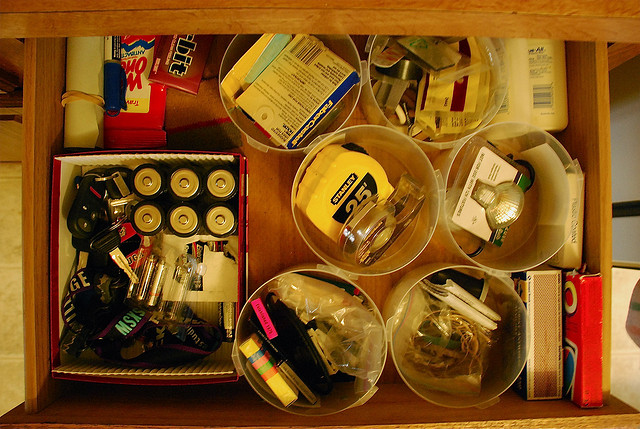Chip in to keep stories like these coming.
Imagine this conversation with a friend.
“You know, I just love my cutlery drawer. I mean it’s just the perfect place to store things.”
“You mean, like knives and spoons and …”
“No! Everything!”
“Boots? Hats? Pickle jars? Underpants?”
“Everything. I can’t imagine ever having to need any other kind of place to put stuff!”
“But, you know there are closets, shoe racks, pantries and bureaus for that other stuff.”
“Looked in them once. Not for me. I’m happy with my cutlery drawer. I’ll leave that other stuff to you storage nerds.”
Lately I’ve been having that conversation a lot with friends and family lately. Well, not about cutlery drawers, but about software in general and digital collaboration tools in particular.
Take Dropbox, for example. I know folks who treat it like the perfect tool for online collaboration. Dropbox is fine for sharing a file or groups of files, or even for crudely collaborating on them asynchronously. But, compared to other similar services like Google Docs and One Drive, it’s showing its age. And, it certainly is not an ideal tool for broader group collaboration. In comparison to, say Slack or Basecamp or Igloo, for example, it is laughably underpowered. Using it as a Basecamp substitute is exactly like using a cutlery drawer to store underpants and pickles. Basecamp allows teams to share documents, to dos, calendars, files and project plans.
And, it easily allows users to manage versions and maintain a canonical version of files without folks uploading and downloading copies of Word docs. Slack is an great substitute for the tedious email trails that go no where when teams try to use email as a different kind of cutlery drawer. A lot of high-functioning teams use both Basecamp and Slack (and Google Docs, and Google Hangouts). Why? Because they realize that there is no one perfect tool (or storage bin) for every job.
The cutlery drawer folks will argue that they don’t need anything as “fancy” as Basecamp and its ilk. That it is far simpler for them just to use Dropbox, or attach files to email etc. But, that’s a false economy. It is often the case that what are deemed as “simple” solutions employ far more complicated workflows than bespoke software tools offer.
Yes, you could create folders within folders to store all your pictures and videos for an online publication. Or you could keep them in a collaboration tool that allows you to easily associate them with specific projects (or sets of projects) assign the files to specific to dos or events or track the progress of the files through a editorial workflow.
Plus it’s a great example of what I call the absolute assurance of total technological ignorance. That’s the remarkable gift of folks who have no interest in or knowledge of software to suddenly become an expert when asked to use it. “Oh, it won’t do anything my to dos on Post-It notes won’t handle.”
Now, if an organization really only needs to exchange a single file from time to time then, sure, a simple file sharing tool is the perfect slot for that task. But, most organizations don’t work like that.
And, the reality is, that most organizations, even small ones, quickly outgrow the cutlery drawer but are simply too accustomed to its quirky, limiting ways to move on. Or, and this is often the case, organizations will try a new collaboration tool but timidly won’t commit completely and wind up with a project with half the files buried in emails and the rest in the new tool. Then they give up to the cheers of the email lovers who balked at the new system to begin with. Like smoking cessation, cold turkey is the tough love required.
I am heartened, though. As collaboration tools become almost frictionless and mobile devices more capable of using them fully, the resistance is fading. Someday soon, I hope, no one will find underpants beside the forks.
Wayne MacPhail has been a print and online journalist for 25 years, and is a long-time writer for rabble.ca on technology and the Internet.
Chip in to keep stories like these coming.




